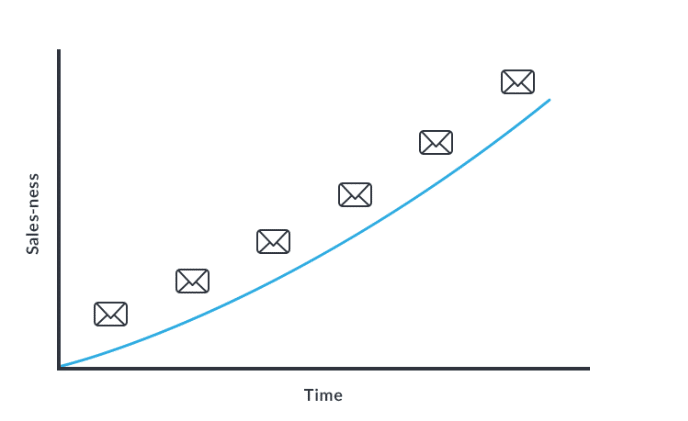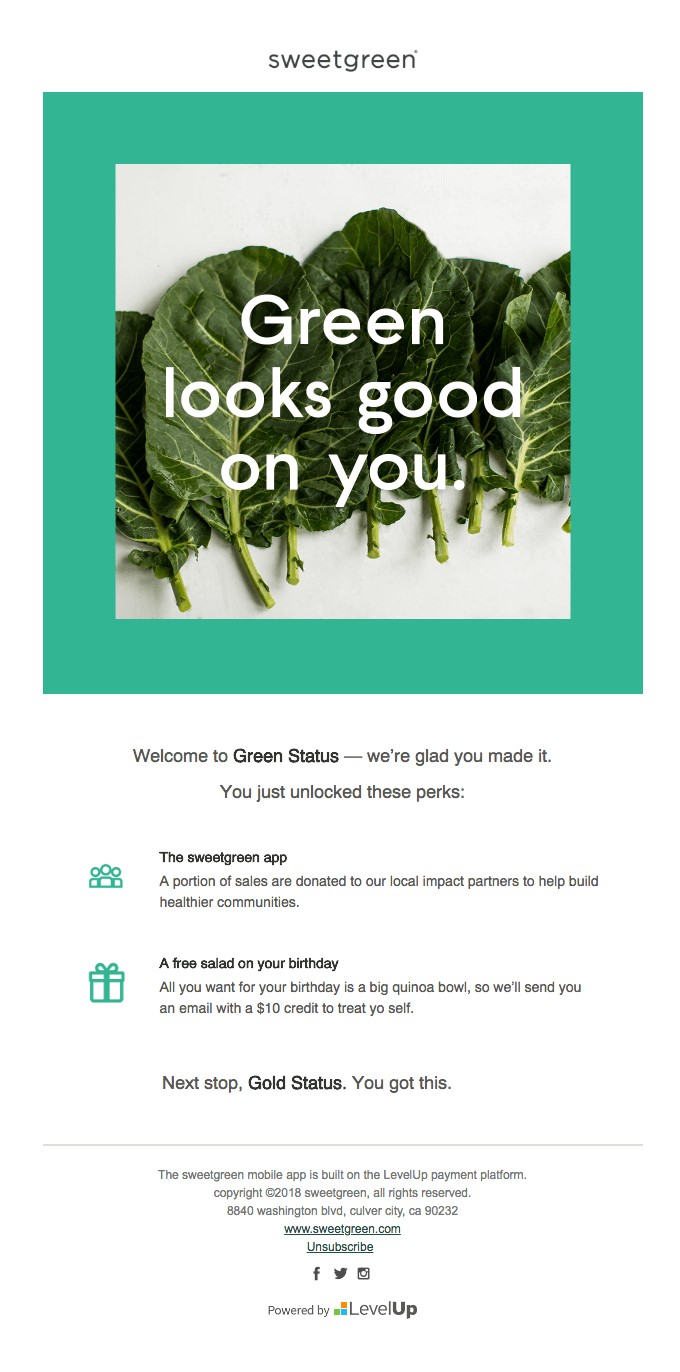This post has been updated as of May 2019
Does your business have salespeople whose job it is to convert new leads into customers?
If so, it’s an unfortunate fact of life that over 50% of leads generated by businesses are qualified but not yet ready to buy.
So what are you supposed to do with those leads? You’ve spent valuable time and money getting them, so you need to do something. Email marketing is the way to go.
Read on to learn how to set up a simple email workflow that can help convert more of those leads into customers over time.
How email can help convert leads into customers
For illustration’s sake, let’s imagine you sell carpet cleaning services.
You have a great website where people can read about your services, and you generate leads through a “Request a Quote” form on the site.
You get 15-20 people who submit that form every week, and the people in your sales team get back to every one of those inquiries with quotes based on the information they submitted.
Unfortunately, though, only about 50% of the people you spend time crafting quotes for ever become customers. The other 50% you never hear from again.
So how can email help you?
By setting up an automated email workflow to deliver specific content and messages to these leads, you can keep in touch with them and help convince them they need your product or service.
The best part about it is that it can all be automated. So, while you’re busy generating more inquiries, these emails can be working to close your existing leads in the background and increase revenue for your business.
A simple 5-part email workflow to convert leads into customers
While it can be tempting to just continually send these people promotional emails for your service, that approach isn’t likely to get you the best results.
For whatever reason, these people have shown strong initial interest, but haven’t yet chosen to go ahead with using your product or service. Continually promoting your business to them won’t change that.
Instead, what you need to do is educate them on some of the key things you’d want them to know—the kind of things that, if they knew, they’d be purchasing your services right away.
In the case of our example carpet cleaning company, that might be the hidden health dangers of having unclean carpets, and the advantages of using professional carpet cleaning services over doing it themselves.
The best way to achieve this is to set up an automated series of emails that goes out to leads who make an inquiry but don’t go on to become customers.
The early emails should be mainly focused on adding value and educating your leads that help you to build a relationship with them over time. Then your emails can become more promotional.

Continuing using the fictitious carpet cleaning company as an example, let’s dive in and see how each email could look.
1. The educational email
The first email in the series should be focused solely on providing valuable information to your leads.
As they have expressed interest in carpet cleaning services, it’s probably safe to assume they’re interested in getting their carpets looking good again.
So sending them an email with a link to a blog post on six ways to make their carpet look like new is the perfect way to engage them.
By providing them with valuable information related to your business’s area of expertise, you build a sense of authority around your brand that shows potential customers you know a lot about making carpets look great.
2. The problem email
The second email in the series should still be focused on providing valuable information, but, this time, your goal should be to educate leads on why the problem they came to you about is worth solving.
A good example for our fictitious carpet cleaning business would be a link to an article on the dangers of not regularly cleaning your carpet, and the risks this poses to your family’s health.
Although still educational, this email demonstrates to your leads why their problem is important and helps create a sense of urgency that compels them to seek out a solution.
3. The solution email
Now that you’ve convinced your leads that their problem is important and worth solving, it’s time to convince them that your product or service is the answer.
For our fictitious carpet cleaning organization, it’d be great time to send leads a link to an article on the advantages of using professional carpet cleaning services over doing it yourself.
Although still educational, this email helps convince your leads that they need a professional service like yours and gets them thinking about who the right provider might be.
4. The case study email
Now that you’ve shown leads that their problem is important and that they need to find a proper solution, it’s time to prove that you’re the right provider for them.
Continuing our carpet cleaning example, now is the perfect time to send them a case study or some testimonials that outline how great your business is to work with and how amazing the results have been for your customers.
This email, combined with the sense of expertise you’ve built around your business by continually sending educational content, should give your leads confidence that your business is the right choice and compel them to respond to your quote and purchase your services.
5. The Hail Mary email
If, at this stage in the series, you haven’t convinced your leads to purchase, then your chances of converting them are looking a little slim. It might be time to throw the Hail Mary pass.
In the case of our fictitious carpet cleaning business, this means offering something like a 20% off the quoted price as a last-ditch incentive to get them over the line.
Although this may reduce your margins a little bit, this is the last email in the series and, likely, your final chance to convert them into a customer, so it’s probably better to get them at a slightly discounted rate then to not get them at all.
Setting this up for your business
The series of emails above are a great way to turn leads into customers. They demonstrate to your leads the importance of fixing their problem and position your product or service as the ideal solution.
So how can you get them set up and working for your business?
Your best bet is to integrate your CRM or website with your email marketing software and set up a series of automated emails using automation.
Emails tools like Campaign Monitor integrate easily with popular CRM systems like Salesforce, Highrise, Zoho CRM, Pipedrive and more. You can set up tags or rules (depending on your chosen system) that automatically send leads that haven’t purchased into a specific list in your email marketing software.
From there, you can use automation to automatically send the above series of emails to new leads as they get added to your list.
By setting it up like this, these emails can be automatically sent to new leads as they enter your list and can be working to increase revenue, while you focus your time and energy on other parts of the business.
While automating the delivery of these emails can greatly enhance your efficiency, you still need to be strategic. You can’t just “set it and forget it.” It’ll be important to run analytics on your emails and make comparisons to determine what works in order to send emails with rich content that adds value to your subscribers’ inboxes.
By analyzing your successful emails, you can use those insights to tailor campaigns to nurture prospects in the future for automation workflows.
Automation pros
One of the major pros of these email campaigns is that, as lead nurture based emails, these are the right tools for turning prospects into customers. So you’re certainly on the right track.
Other major pros include format and repeatability. By having a basic format to follow, you can use the same ideas for more specialized email marketing campaigns in the future.
For example, consider the educational email campaign. With so many more customers putting a premium on marketing that’s informative rather than strictly promotional, using educational email campaigns is far more worthwhile.

Source: Really Good Emails
Automation cons
Take what you learned from reading about the Hail Mary email campaign. This email campaign is characterized by following up with the lead one last time with a substantial discount. While this approach can work, its efficacy depends on other factors, such as how your leads will perceive it. Will your leads take it as a desperate attempt for attention, or a hallmark of good business?
Whether or not these email campaigns will work well for you comes down to a couple of key points. First, when using any of these five workflows or any other lead nurture based email campaigns, always remember to personalize it. While these emails can be automated, somewhat personalized responses are still key to success.
For example, if a lead abandons your signup form because there was a section they felt uncomfortable filling out, email them about signing up and remove that requirement. Being accommodating can go a long way in email marketing.
Overall, there are no major cons to these email campaigns, but there are right and wrong ways to use them. Make sure you’re using the campaign style that matches your leads to maximize overall engagement. And always follow up with these campaigns. Even with all the pros on your side, you still won’t see much of a return if you don’t continue with follow-ups.
What is a lead nurturing campaign?
One of the most effective tools in marketing is the lead nurturing campaign. Lead nurturing refers to the process of prepping and priming a lead into a potential long-term customer. The practice is built on the idea of growing customer relationships.
One of the most important things to remember about lead nurturing is that it starts far before the point of actually approaching the customer, whether it be via email, social media, or other platforms. Leads should be qualified and segmented before continuing to sending automated marketing emails.
After determining what the lead is interested in, a typical lead nurturing tactic is to set up a drip campaign. A drip campaign consists of scheduled emails that’ll be sent every so many days to gradually build the lead’s interest in your brand.
Wrap up
If your business acquires new customers by generating leads and having salespeople do quotes and close them, then it’s an unfortunate fact of life that 50% of those leads aren’t going to be ready to purchase up front.
However, by setting up an automated series of emails that educates leads on the significance of their problem and why your business is best positioned to solve it, then you might have a shot at converting some of those leads into customers over time.
So set up an integration between your email marketing software and your CRM or website today, and start sending this automated email series to that’ll grow your business.
Now that you understand the different types of email automation campaigns that work, check Campaign Monitor’s 4-step guide to implementing it into your strategy.
This post was originally published in May 2015





